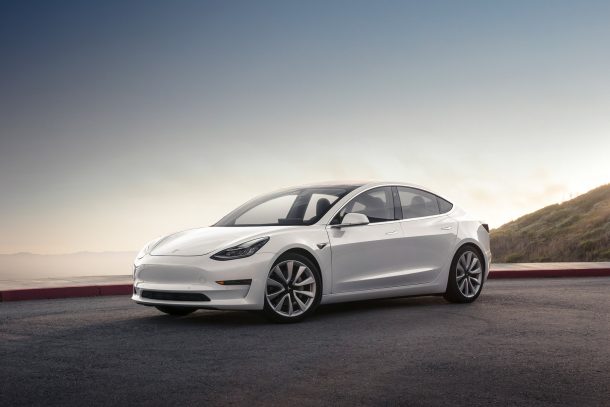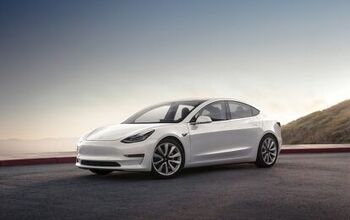Tesla's Third-quarter Model 3 Deliveries Fall Short of Target

If that headline was a tweet, it would certainly qualify as “evergreen.”
With Model 3 production having ramped up towards the very end of the previous quarter, Tesla production in the third quarter of 2018 totalled 80,142 units, some 53,239 of them Model 3s. Compared to the 53,339 vehicles built in Q2 2018, it’s a hefty increase in output.
However, lost in the megaton-yield controversies that follow Tesla CEO Elon Musk like a stray dog in search of a home is the fact that Q3 production didn’t quite make it to an oft-promised target.
Maybe we’ve moved beyond caring about Muskian promises, choosing to give them the weight they deserve, as the failure to meet this latest target didn’t meet with an avalanche of press. Many words reached pages about other Tesla matters, that’s for sure.
In its quarterly production update, Tesla claims it delivered 55,840 Model 3s to North American customers in July, August, and September, achieving a production rate of 5,300 Model 3s in the last week of the quarter. That’s only about 300 cars/week more than the rate hit at the end of Q2 — a met target that prompted much fanfare.
Tesla stated that the bulk of the Model 3s produced in Q3 were pricier, dual-motor variants, which carry a premium on top of the rear-drive Long Range models that kicked off production last year. This means “we achieved a production rate of more than 10,000 drive units per week,” the company said, as if anyone had assigned a target to drive motors.
At the end of Q2, Musk reiterated a promise that Model 3 production would reach a rate of 6,000 vehicles by the end of August. While the value and margins of the Model 3s rolling off the two Fremont, California assembly lines no doubt increased (much to the company’s benefit), overall production lagged in expectations. Over the course of Q3, Model 3 production averaged 4,018 vehicles per week. Yes, getting the dual-motor vehicle onto the line may have led to slowdowns, and any number of other elements could factor in. But stark numbers have a way of tossing wet blankets on top of stark promises.
The future, of course, will be different, Tesla claims, and it needs to be different for Tesla’s bottom line.
“There remain significant opportunities to grow the addressable market for Model 3 by introducing leasing, standard battery and other lower-priced variants of the car, and by starting international deliveries,” Tesla stated.
Yes, an opportunity exists in building the $35,000 version of the car promised when the model was unveiled on March 31, 2016. Two and a half years ago. By the end of the night, the number of preorders totalled in the six-figure range, and the low, “electric car for the masses” price tag featured prominently in every news story. Musk now claims that the base Model 3 will reach customers in early 2019.
Sorry for the negativity, CleanTechnica.
Another promise made earlier this year was that the automaker would be in a cash-positive position by the end of it, with higher-priced variants of the Model 3 understandably serving to boost its profitability. Tesla has not yet released its Q3 financials. Money, and quite a bit of it, will be required to complete the company’s Shanghai factory — a plant critical to Tesla’s future Chinese sales. Currently, the 40 percent tariff levied on imported American vehicles means Tesla models sell at a “55% to 60% cost disadvantage compared to the exact same car locally produced in China,” according to the automaker.
By building locally, Tesla would not only free itself from tariffs, its cars would also find themselves the recipient of state incentives totalling up to 15 percent of MSRP.
[Image: Tesla]

More by Steph Willems
Latest Car Reviews
Read moreLatest Product Reviews
Read moreRecent Comments
- Theflyersfan I wonder how many people recalled these after watching EuroCrash. There's someone one street over that has a similar yellow one of these, and you can tell he loves that car. It was just a tough sell - too expensive, way too heavy, zero passenger space, limited cargo bed, but for a chunk of the population, looked awesome. This was always meant to be a one and done car. Hopefully some are still running 20 years from now so we have a "remember when?" moment with them.
- Lorenzo A friend bought one of these new. Six months later he traded it in for a Chrysler PT Cruiser. He already had a 1998 Corvette, so I thought he just wanted more passenger space. It turned out someone broke into the SSR and stole $1500 of tools, without even breaking the lock. He figured nobody breaks into a PT Cruiser, but he had a custom trunk lock installed.
- Jeff Not bad just oil changes and tire rotations. Most of the recalls on my Maverick have been fixed with programming. Did have to buy 1 new tire for my Maverick got a nail in the sidewall.
- Carson D Some of my friends used to drive Tacomas. They bought them new about fifteen years ago, and they kept them for at least a decade. While it is true that they replaced their Tacomas with full-sized pickups that cost a fair amount of money, I don't think they'd have been Tacoma buyers in 2008 if a well-equipped 4x4 Tacoma cost the equivalent of $65K today. Call it a theory.
- Eliyahu A fine sedan made even nicer with the turbo. Honda could take a lesson in seat comfort.


































Comments
Join the conversation
"Another promise made earlier this year was that the automaker would be in a cash-positive position by the end of it, with higher-priced variants of the Model 3 understandably serving to boost its profitability." Tesla has negative operating cash flows. So when Tesla makes stuff and sells it, it's losing money in the process. The more cars that Tesla sells, the more money that it loses. Given its performance to date, selling more cars will make Tesla's situation worse, not better. "Money, and quite a bit of it, will be required to complete the company’s Shanghai factory" Tesla will need to borrow it or find investors, since it doesn't make money from the business itself. Tesla has been fortunate in its ability to obtain capital even though it bleeds losses. Time for that may be running out.
No point to make, but Tesla makes 5000 Model 3’s a week. Porsche sells about 5000 cars a month. Despite everything it is still remarkable how far they’ve come.